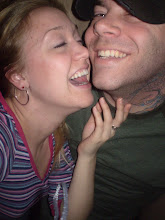So week two was right down to business! Our class went well, reviewed some terms that we all had to define and messed around with "Photoshop" a bit, then ended by reading our syllabus for the weeks homework. I thought wow, not bad just some reading then blog..... wrong! The reading was pretty intense this week! Nothing devastating, just full of numbers and equations, terms and definitions, examples with captions?! I enjoy the book, oh we're still reading from "The Non-Designers Web Book," for me though I don't appreciate how the book defines things then adds that you really don't need to remember that, just thought we should give you a definition because you'll hear it a lot. I just think that is weird.
I did get a lot from the reading this week, really cool facts that clear up some "I wonder why" questions from in the past. I have worked for a printing company in the past so I knew about CMYK (Cyan, Magenta, Yellow, blacK) but didn't know about RGB or Indexed color. For me it was nice to read that if you want to make the file size smaller one way is to index an image and when doing so, you can choose the color palette. The part about Bit depth was a bit in depth. I'm still in a one bit world that's for sure! From there we read more about gif"s and jpeg's, cross platform fonts, cascading style sheets and so on. The underline point (which you have to be careful when using underlines) is resolution. From my findings, resolution quietly runs or truthfully, slows down the computer world.
Resolution in both print and monitor resolution are important, but complete opposites. The higher the dpi (dot per inch) number the better the print quality but choosing the lower number for monitor resolution will give you better visual quality. Recommended pixel setting in between 72 or 96 for images to show up best on multiple computers and configurations. Resolution is even necessary with everyday computer use. I now know that it is important to make changes to a digital picture prior to sending it to a friend or adding it to my blog. Really it just makes sense and is fairly simple to do and while you're at it, why not make a good picture into a great one! The main focus on getting a photo "web ready" is to make it easier to use and view. so like I mentioned earlier, first thing, set the resolution to 72, this will shrink the photo to a smaller size right from the start. Next re-size the photo itself. Crop it, cut people out, whatever you want really, just make the actual focus and purpose for the pic be known and at the same time you'll be making the file size smaller. Now pending on what kind of pic you are sending, you can shrink the file size even further by choosing to index an image. I explained this earlier too. On the same line, you can choose the quality of the pic, does it have to be high quality? Most e-mail or blog photos would be just fine in a lower setting which again will shrink the file. After these few changes, it is important to choose the appropriate File format. By choosing the correct format such as giff, or jpeg, you will be able to keep the overall quality of the picture as well as not taking up too much space on a web page that is being loaded for your viewer.
So with that said, I needed to try out some of these things for "hands on" experience. I tried to edit some pics in the free photo editing site of Picnik for starters, not a fan. My wife is able to use this site and use it well but I didn't like the feel of it compared to Photoshop since that is what we use in class. I then downloaded Gimp. What a difference! It is very similar to Photoshop just not as smooth. Some of the terms are different and harder to find but overall it has most of the same features and I can't complain....... it was free!
Subscribe to:
Post Comments (Atom)





No comments:
Post a Comment